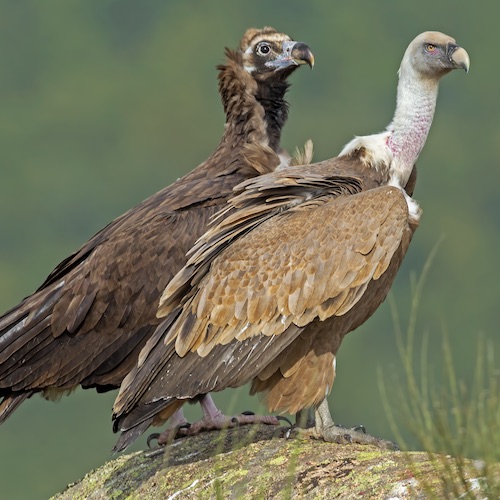LINKED PAPER
Implications of bacterial, viral and mycotic microorganisms in vultures for wildlife conservation ecosystem services and public health. Pablo I. Plaza, Guillermo Blanco & Sergio A. Lambertucci. 2020. IBIS. DOI: 10.1111/ibi.12865 VIEW
It has been suggested that obligate scavenger birds (vultures and condors) are resistant to microorganisms present in the environment, especially those present in their diet. This resistance is probably associated with different physiologic characteristics of these species (Roggenbuck et al. 2014, Blumstein et al. 2017). However, until now, there was not any comprehensive review addressing if obligate scavenger birds are resistant to microorganisms or if those microorganisms can cause disease in them. In addition, whether obligate scavenger birds may spread pathogens to humans and other animal species, or if they may act as disease regulators, has been poorly studied.
We examined results from 76 published studies about microorganism present in obligate scavenger birds around the world. We found that bacteria, virus and mycotic microorganisms colonize these birds. Some of them are zoonotic, with the potential to cause severe disease in humans. Moreover, some bacteria present in these species showed multi antibiotic resistance. Predictable anthropogenic food subsidies could be an important source of pathogen microorganisms for obligate scavengers. In this sense, supplementary feeding stations and rubbish dumps are important sources of microorganisms for these individuals (Blanco 2018, Plaza et al. 2018). Some microorganisms produce health alterations of variable degree affecting obligate scavengers’ fitness and even producing the death of some individuals. For example, oral ulcers, enteritis or abscesses associated with different microorganisms have been reported affecting these species in different parts of the world (Panangala et al. 1993, Pitarch et al. 2017).

Andean Condor © Bruno Osorio
Compared with facultative scavenging bird species such as gulls (Bonnedahl & Järhult 2014) there was no clear evidence that obligate scavengers play an epidemiological role spreading pathogens or antibiotic resistance to humans and other species. However, this merits future research applying different techniques. On the contrary, vultures and condors may help to prevent the spread of infectious diseases when they consume and remove decomposing carcasses from the environment. This is because carcasses are breeding grounds for potentially pathogenic microorganisms, thus, through their ingestion obligate scavengers eliminate this source of microorganisms from the environment. In addition, these birds could eliminate pathogens when they pass through their gastrointestinal tract by means of the low stomach pH and intestinal microbiome (Houston & Cooper 1975, Roggenbuck et al. 2014). Future research is needed to address if this avian group may mitigate infectious diseases in order to define with scientific evidence the ecosystem services they provide when they remove carcasses from the environment.
Vultures and condors are one of the most threatened avian groups in the world. They are facing multiple serious threats including lead contamination, persecution, the trade of body parts, but especially intentional poisoning (Ogada et al. 2012). In this sense, pathogen microorganisms could be an overlooked threat affecting them, especially when acting synergistically with the other threats.
Our article shows that there is no clear scientific evidence that vultures and condors play a role in the spread of microorganisms and antibiotic resistance to other wildlife, livestock and humans. On the contrary, they may act as cleaners of the environment limiting the spread of pathogenic microorganisms, although more research is needed on this. The information we provided could be very useful to promote the ecosystem service benefits of these species and be used as an important tool for their conservation.
References
Blanco, G. 2018. Supplementary feeding as a source of multiresistant Salmonella in endangered Egyptian vultures. Transboundary and emerging diseases. VIEW
Blumstein, D.T., Rangchi, T.N., Briggs, T., De Andrade, F.S. & Natterson-Horowitz, B. 2017. A systematic review of Carrion Eaters’ adaptations to avoid sickness. Journal of wildlife diseases 53: 577-581. VIEW
Bonnedahl, J. & Järhult, J.D. Briggs, T. 2014. Antibiotic resistance in wild birds. Upsala journal of medical sciences 119: 113-116. VIEW
Houston, D.C. & Cooper, J.E. 1975. The digestive tract of the whiteback griffon vulture and it’s role in disease transmission among wild ungulates. Journal of Wildlife Diseases 11: 306-313. VIEW
Ogada, D.L., Kessing, F. & Virani, M.Z. 2012. Dropping dead: causes and consequences of vulture population declines worldwide. Annals of the New York Academy of Sciences 1249: 57-71. doi: 10.1111/j.1749-6632.2011.06293.x. VIEW
Panangala, V.S., Stringfellow, J.S., Dybvig, K., Woodward, A., Sun F., Rose, D.L. & Gresham, M.M. 1993. Mycoplasma corogypsi sp. nov., a new species from the footpad abscess of a black vulture, Coragyps atratus. International Journal of Systematic and Evolutionary Microbiology 43: 585-590. VIEW
Pitarch, A., Gil, C. & Blanco, G. 2017. Oral mycoses in avian scavengers exposed to antibiotics from livestock farming. Science of the Total Environment 605: 139-146. VIEW
Plaza, P.I., Blanco, G., Madariaga, J., Boeri, E., Teijeiro, M.L., Bianco, G. & Lambertucci, S. 2018. Scavenger birds exploiting rubbish dumps: Pathogens at the gates. Transboundary and emerging diseases. VIEW
Roggenbuck, M., Schnell, I.B. erholm, Blom, N., B\a elum, J., Bertelsen, M.F., Sicheritz-Pontén, T., Sørensen, S.J., Gilbert, M.T.P., Graves, G.R. & Hansen, L.H. 2014. The microbiome of New World vultures. Nature communications 5. VIEW
Image credit
Featured image: Eurasian Griffon and Cinereous (Black) Vultures © Jorge de la Cruz




